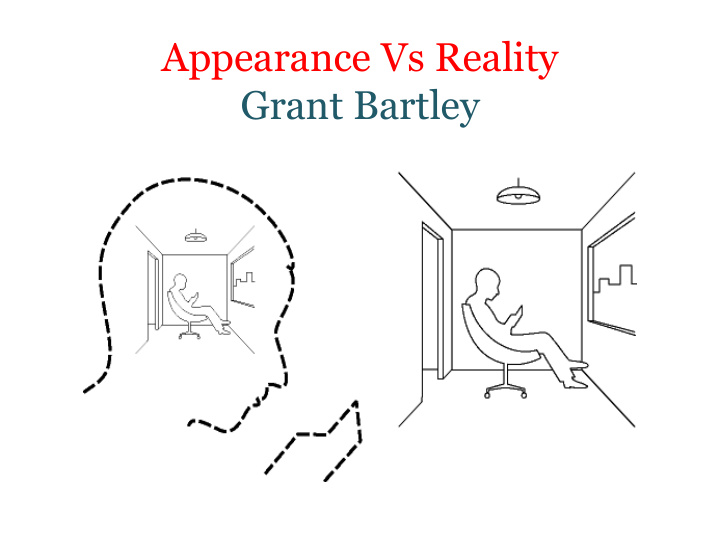



Appearance Vs Reality Grant Bartley
Imagine you couldn’t see, hear, or feel anything …
… would you know the world had 3D objects in it?
The basic mechanics of hearing
The auditory cortex in relation to the ears
Some neuronal signalling
A Neuron
Molecules at a neuronal synapse
Axon meets dendrite
Front Back
Every sensation you have of the world is created as a result of nervous activity
Your brain represents reality for your mind
So w hat’s in your experience is not the real world itself ≠
Brain activity enables all thought
Our brains are in the vats of our skulls
How can I know I’m not dreaming?
Descartes (1596-1650)
ALL our experience – of dreams, or reality – is made up inside our brains!
Some sensations
Colours and other sensations are only in our minds, not in things themselves out in the world
The experience of music ≠ The physical basis of sound ≠
Sugar isn’t sweet unless someone’s tasting it… (Looks sweet though, doesn’t it?)
‘Grass is green’ means only that it has the potential to sometimes induce an experience of green
How could a colour exist without being either seen or imagined?
What colour is this ball really ? What does your answer mean ? ?
The frustration isn’t a property of the car itself
A BASIC DISTINCTION: THE WORLD AS IT APPEARS TO US TO BE ≠ THE WORLD AS IT IS IN ITSELF
What we directly see or experience is only the appearance of things Reality in itself exists beyond the experience
Galileo (1564-1642) An early (meta)physicist
The first set of essential metaphysical distinctions: 1 The primary qualities (intrinsic) of objects – their shape, mass, motion, etc. Vs 2 Their secondary qualities (sensed): their visual appearance, sound, etc
The second set of essential metaphysical distinctions: 1 The internal world of (your) mind and its contents Vs 2 The external world of physical reality as it is in itself (and, technically speaking, other minds too).
An essential, if confusing, metaphysical fact: All our experiences of the external world exist only in our internal world s
Immanuel Kant (1724-1804) in the external world
Descartes’ solipsistic question rephrased: How can I know that anything exists beyond my conscious awareness and its contents?
We perceive ourselves making choices
≠
THE DISTINCTION AGAIN: , The phenomenal world = the world as it appears to us to be. The noumenal world = the world as it is in itself.
Another appearance of Immanuel Kant
Gottfried Wilhelm Leibniz (1646-1716)
Plato idealised (427-347 BC)
Kant: ‘Causality is not a feature of the world as it is in itself’
Even our perception of how we come to represent the world is itself a representation
Brain activity models reality for our minds
Different areas processing vision
What is the ball really like independent of our experience?
What is reality really like independent of human experience?
Western philosophy and science started here
Recommend
More recommend